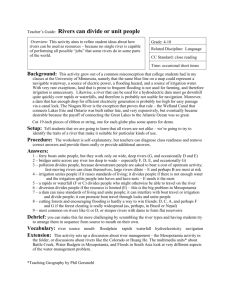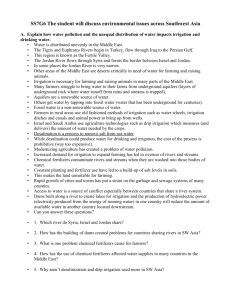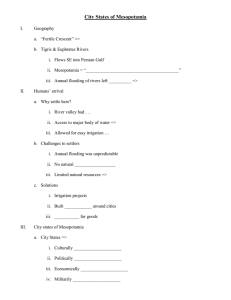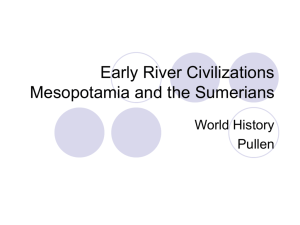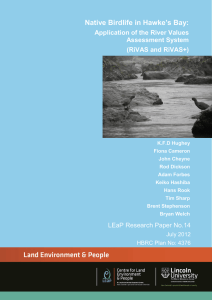Ranking New Zealand river values – ‘chalk and cheese’ problem
advertisement
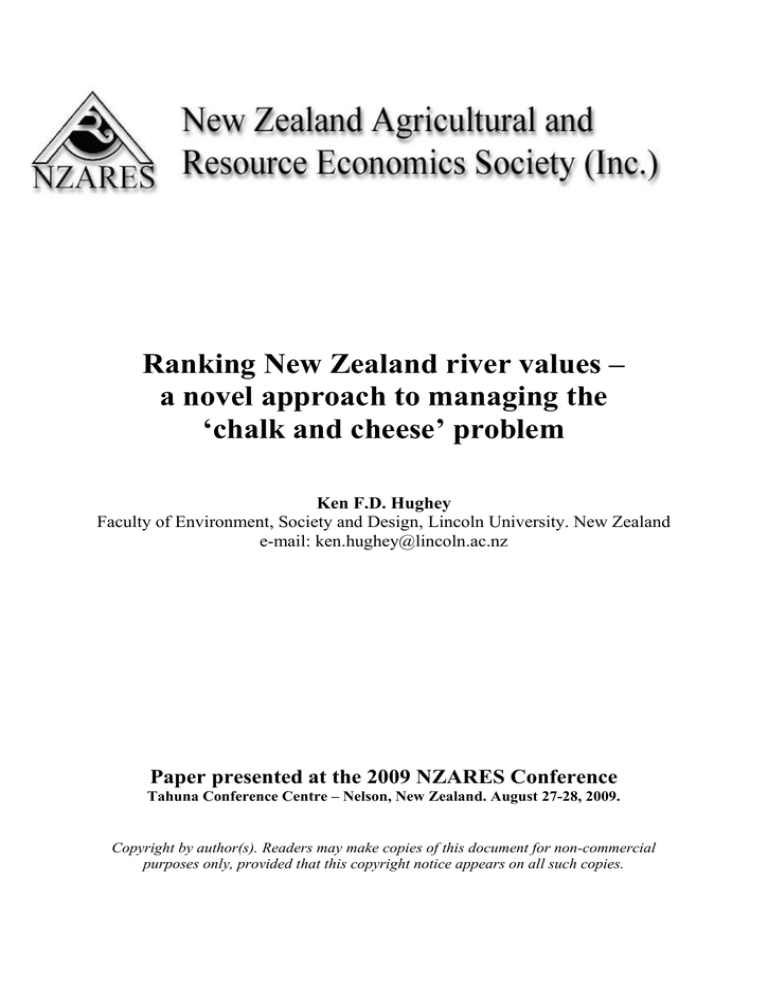
Ranking New Zealand river values – a novel approach to managing the ‘chalk and cheese’ problem Ken F.D. Hughey Faculty of Environment, Society and Design, Lincoln University. New Zealand e-mail: ken.hughey@lincoln.ac.nz Paper presented at the 2009 NZARES Conference Tahuna Conference Centre – Nelson, New Zealand. August 27-28, 2009. Copyright by author(s). Readers may make copies of this document for non-commercial purposes only, provided that this copyright notice appears on all such copies. Ranking New Zealand river values – a novel approach to managing the ‘chalk and cheese’ problem Ken F.D. Hughey, Faculty of Environment, Society and Design, PO Box 84, Lincoln University, Lincoln 7647, New Zealand. Email: ken.hughey@lincoln.ac.nz Summary In New Zealand, regional councils have the task of sustainably managing rivers and their flows. In trying to achieve this task they face enormous challenges including the need to allocate flows amongst often highly disparate in- (e.g., angling, kayaking, native fish and birds) and out-of-river (e.g., irrigation and hydro energy) values/needs. To aid in this task these councils need to know which rivers or parts of rivers are relatively more or less important on national, regional and local bases, for particular values. This task becomes even more challenging given limited information availability for many values, and no overarching policy or decision framework. In this paper I report on a FRST-funded (and less than 1-year long) project which has addressed these challenges. A multi-criteria and expert panel based methodology has been developed and applied to a wide range of values to produce lists of rivers by value, ranked according to their national, regional and local importance. The methodology is described and example applications given. The need to ‘buy-in’ multiand, ultimately, interdisciplinary participation is emphasised as well as a range of ongoing implementation challenges and further needs. Key words: River values, prioritisation system, irrigation and birdlife, New Zealand 1. Introduction Hearing panels at multiple levels of local and central government, the Environment Court, and local and central government generally, have for decades been seeking an objective method for ranking the comparative value of rivers for the range of in- and out-of-stream uses. Historically, Teirney et al. (1982) for recreational trout and salmon fisheries, and Egarr and Egarr (1981) for whitewater kayaking, identified lists of rivers and streams for their relative importance for these values. More recently, the relative importance issue was addressed under the Water Programme of Action, part of the Labour Government’s 2003 Sustainable Development Programme of Action, run by Ministry for the Environment (MfE). The programme identified the need for the Department of Conservation (DoC) to identify water bodies of national importance (WONI) and a list of water bodies that would protect the full range of freshwater biodiversity values. In a complementary way MfE (2004) listed water bodies important for recreation, and MfE and MAF (2004) produced lists of waters of national importance for: the biodiversity dimension of natural heritage; geodiversity and geothermal features; recreation; irrigation; energy; industry and domestic; and tourism. But, despite much work in this context there remains no objective framework that clearly identifies the criteria upon which importance is determined for specific values, or which allows for comparison between values. In this paper I describe the FRST-funded1 river values project and how it provides a tool that enables regional 1 Prioritising River Values - FRST Envirolink Grant 612-TSDC41 councils to rank rivers by value, and others to use the tool within appropriate contexts for a variety of purposes. 2. Background and need There are multiple situations within the Resource Management Act 1991 (RMA) for consideration of relative importance, e.g., - Policy Statements: draft National Policy Statement (e.g., ‘Identify notable values of outstanding freshwater resources’) - Regulations: National Environmental Standard - Ecological flows draft (the technical process involves assessing aquatic values and their relative significance) - Orders: Water Conservation Orders (outstanding amenity or intrinsic values, habitat, fishery, wild, scenic or other natural characteristics, scientific or ecological value, recreational value) - Plans: Regional and District. While each of these needs has been addressed to some extent all such attempts have used different methods, often relying on a high degree of subjectivity. Typical of the outputs produced are: - Schedules of water bodies to be managed for specified purposes - Schedules that list values of water bodies. Most often the lists are water quality and discharge management related, the language used is very variable, and there is little or no connections between regional and national value. Even in the MfE and MAF (2004) ‘Potential Water Bodies of National Importance’ report, which provides lists of rivers across multiple values, there is no unifying methodology and no clear thresholds for the different levels of importance. With the demands on freshwater being increasingly contested (see for example MfE 2007) there is a call for a prioritisation tool that: - works regionally but also has national level application potential - will work with the best available information - is user friendly - when applied, provides defensible (e.g., Environment Court) results. Tasman District Council (TDC) is in the process of reviewing its Regional Policy Statement – they need to know which water bodies are more or less important for particular values but have no tool to do this. In 2008 TDC approached Envirolink (a FRST funding source for designated councils) for assistance. Based on this approach the Foundation provided the following support, over 3 stages: - small advice project (2008 – review the scope of the opportunity); - medium advice project (2008/09 – a national workshop to firm up need, finalise values and begin work on methodology and salmonid trial application); - tools project (2009 – multiple values, national workshop, council applications) – this is a very short term project, i.e., February-August 2009. 3. Study approach We first established a project steering group: myself, Mary-Anne Baker (TDC), Murray McLea (Greater Wellington RC), John Hayes (Cawthron Institute), Neil Deans (Fish and Game Nelson-Marlborough). The steering group met and decided a course of action, namely we: - Initiated a literature review (see Smith 2009) – who had tried this before across a range of in- and out-of-stream values and what lessons could be learnt? There was some work within values, e.g., whitewater kayaking (Egarr and Egarr 1981), birdlife (O’Donnell and Moore 1983, O’Donnell 2000), and recreational angling (Teirney et al. 1982), and of course more recently in the WONI project. This review showed that no one, it seems, had developed a system to look objectively/ quantitatively or in a standardised way across a range of values. - Given the above finding we then much debated and developed a draft methodology (see Hughey et al. 2009) and undertook a trial with salmonid fisheries in TDC (see Booth et al. 2009). Based on a successful application to salmonids we decided to then apply the draft methodology to a range of other values at selected councils, a planned national workshop to test and verify the approach, and a proposed full trial at TDC. The values being tested, the host regional council, and current progress are: Salmonids – Tasman: done Irrigation – Canterbury: criteria developed; under peer review Birdlife – Canterbury: criteria developed; draft completed Native fish – Wellington: in progress Iwi – Southland: in progress Natural character – Marlborough: criteria developed; draft underway Swimming – Manawatu: September Whitewater kayaking – West Coast: October. 4. Methods Smith’s (2009) review of the literature was informative – no system had been developed that provided a standard approach for ranking river values. However, notwithstanding this conclusion it was clear that considerable good research, at a high level of detail, was occurring in some areas, e.g., DoC’s Freshwater Environments of New Zealand approach, and Fish and Game New Zealand’s ongoing national angling surveys. But, some values, e.g., swimming, irrigation and natural character, have no integrated databases or systems for prioritisation, while other values, e.g., kayaking and bidlife, have databases of mixed spatial and temporal quality. Two complementary approaches appeared most likely to address a context of: the paucity of reliable information; lack of an existing method, a short timeline, and limited resouces, i.e., - A multi-criteria driven, standardised numeric scale approach, and - An expert panel based approach. Both approaches are built on the need to use the best available information, and to fill the gaps with expert judgement. Given variable data and lack of a standardised approach we built our method around the key attributes of river values, populating these where possible with real data, and then converting this information to numeric scales for ranking values. The use of expert panels and best available information as the cornerstones of the project, also required us to use carefully controlled quality/peer review processes. Ultimately we developed the following (see Hughey et al 2009 for detailed explanation of each of the processes and steps): A. Define the value to be evaluated, e.g., birdlife, irrigation B. Establish (and carefully justify) the expert panel and choose (and carefully justify) peer reviewers. The expert panel must be capable of considering the national level and application at a regional scale, the members (scientists, consultants, policy makers or lay people) must be nationally respected for their expertise, and ultimately be able to produce work that can be tested at the Environment Court. C. Assessment criteria Step 1: define river value categories, i.e., kayaking can be subdivided into flat water and white water; and river segments; Step 2: identify all of the value’s attributes – economic, social, environmental, and cultural, depending on what is appropriate; Step 3: select and describe primary attributes – reduce to a list of 10 or less, for manageability; Step 4: identify indicators – choose objective/ quantitative over subjective; evaluate each against SMARTA2 criteria – the main aim is to quantify where possible with a majority of indicators represented by scientifically defensible data. D. Determining significance Step 5: determine indicator thresholds – quantify these where possible and think nationally: at the national level it is advised to use criteria set in legislation or determined in the Environment Court, e.g., the 5% level for a national important population of a ‘threatened or at risk’ bird species; Step 6: apply indicators and their thresholds – convert all to 1=low; 2=medium; 3= high, e.g., for birdlife a species achieving the 5% threshold is accorded a ‘3’; Step 7: weight the primary attributes – preferably equal weighting, but otherwise as needed. This part of the process needs to be considered very carefully by the expert panel and subject also to peer review; Step 8: determine river significance – sum total and determine overall importance, e.g., in relation to water conservation order criteria. Also in this case a set of decision support criteria can be identified such that a particular indicator might be so important that if it achieves a ‘3’ then the river is automatically of national important, e.g., the 5% threshold for ‘threatened and at risk’ species; Step 9: outline other factors relevant to the assessment of significance, e.g., there may be particular legal or policy issues surrounding the river that need to be noted such as a Water Conservation Order. E. Method review Step 10: review assessment process and identify future information needs, e.g., survey needs F. Display Outputs 2 SMARTA = Specific, Measurable, Achievable, Relevant, Timely, Already in use Figure 1 shows how the overall approach is integrated. Figure 1: Project overview (Source: Hughey et al., 2009) 5. Results – application to irrigation and birdlife in Canterbury Two of the value prioritisation applications are being developed and applied in Canterbury. Irrigation (Table 1) (Harris and Mulcock in prep.) and birdlife (Table 2) (Hughey et al. in prep.) are both well advanced andt are included here because of their potential to develop potentially comparable findings across the same set of rivers. Key points to note when interpreting these two tables are: - The irrigation expert panel identified 10 primary attributes whereas only six were identified for birdlife; - - - - For birdlife the ultimate importance evaluation was based on the sum or raw scores and/or whether or not the river was defined a species stronghold for a ‘threatened or at risk’ species; For irrigation the ultimate evaluation of importance was based on three approaches (Harris and Mulcock in prep: 6) for defining significance using trigger attributes, predictor attributes or aggregates of attributes as set out below: • National significance is defined by the combined presence of a large water resource (>70 cumecs), a large potentially irrigated area (>100,000 ha), and a soil moisture deficit (Score >=2). • Local significance is defined by the presence of either a small resource (> 5 cumecs), a small irrigated area (>5000 ha) or no significant soil moisture deficit (Score = 1). • The remaining rivers not defined as nationally or locally significant are by default regionally significant. Their ranking approach reflects that while there are other significant issues for suitability of a resource for irrigation, there is the potential to manage these other issues - for example reliability can be modified by storage. However the absence of water and irrigable land cannot be changed. We therefore consider that these should be the major drivers of determining the significance of the resource for irrigated agriculture. Four of the 10 irrigation attributes were evaluated by the expert panel, but only one of the six for birdlife, i.e., the remaining data in both cases were objective and quantitative. 3 3 3 2 29 81.5 National 2 3 3 3 3 3 3 3 3 2 28 80.5 National Rangitata 2 2 42 3154 100 700 270000 2 30% 2 2 2 3 3 3 3 3 3 3 2 27 79.5 National Waimakariri 2 2 32 3784 120 700 141000 3 20% 2 2 2 2 3 3 3 3 2 3 2 25 77 National Waiau 3 3 39 347 11 700 270000 2 30% 2 3 3 2 2 2 3 3 3 3 2 26 60 Regional Sth Ashburton 3 1 26 3059 97 900 54206 1 0 2 3 1 2 3 3 3 2 3 3 2 25 59 Regional Hurunui 3 3 30 2302 73 600 63716 3 0 2 3 3 2 2 3 3 2 2 3 2 25 59 Regional Orari 3 3 24 189 6 600 105012 4 10% 2 3 3 2 2 2 3 3 2 3 2 25 59 Regional Nth Ashburton 3 3 27 315 10 600 105012 4 10% 2 3 3 2 2 2 3 3 2 3 2 25 59 Regional Opihi 3 3 18 378 12 700 141000 3 10% 2 3 3 1 3 2 3 3 2 3 2 25 58.5 Regional Opuha 3 2 28 347 11 600 105012 4 10% 2 3 2 2 2 2 3 3 2 3 2 24 58 Regional Ashley 2 2 32 284 9 700 270000 2 10% 2 2 2 2 2 2 3 3 3 3 2 24 58 Regional Clarence 3 1 26 2271 72 900 1653 1 0 3 3 1 2 2 3 3 1 3 3 3 24 52 Local Hope 3 1 33 1419 45 1200 54206 1 0 1 3 1 2 2 2 3 2 3 3 1 22 38 Regional Hakataramea 2 3 38 757 24 500 24000 4 0% 1 2 3 2 2 2 3 2 2 3 1 22 38 Regional 11668 370 500 212596 10. Socio economic benefit 1. Technical feasibility of abstraction 2. Technical feasibility of storage 3. Reliability (ROR) 4. Reliability (Storage) 5. Size of resource 6. Soil moisture deficit 7. Irrigable area 8. Receiving environment 9. Alternative supply 10. Socio economic benefit Aggregate Ranking from 1 (low, Mackenzie)- 3 (Waipara) (high, Expert assessment) 3=3 3=3 >40% = 3, >20%=2,<20%=1 >3000=3, <100 = 1 >70 = 3,>5 = 2, >1700 = 1,>1200 = 2 > 100,000 ha = 3, > 5000 ha = 2 Rank 5 = 1, 3 and 4 = 2, 1 and 2 = 3 > 60% = 1, > 30% = 2 Direct transfer (3 = 3) Sum National - irrigated area 3, size of resource 3, soil moisture deficit 2 or greater. Local - resource size = 1, irrigated area = 1 or no soil moisture deficit. Remainder regional Primary Attributes and indicators Irrigated area and size of resource cubed, reliability soil moisture and alternative supply +50%, remainder aggregated. Weighting for irrigable area and size of resource only applies if Soil Moisture deficit is >1, otherwise they receive a 50% weighting. 9. Alternative supply Bypass solution ranking from % (maps from CSWS) 4. Reliability (Storage) 53 Expert ranking 8. Receiving environment 3 2 Rank 1 - 5 with 1 being low risk and 5 being high risk (expert assessment) 3 30% 7. Irrigable area 3 2 Irrigable area 3 270000 6. Soil moisture deficit 3 700 Rainfall average over irrigable area 3 203 5. Size of resource 2 6402 Strategic Water study 0% 43 Currently annual volume 2 3 3. Reliability (ROR) 3 2 MALF/ Mean 4% - 72% 3 Rakaia 1. Technical feasibility of abstraction 2. Technical feasibility of storage Rivers Waitaki Expert ranking Table 1: Decision support framework for irrigation (Source: Harris and Mulcock 2009 in prep.) Conversion to threshold values Ranking ROR weighted Ahuriri 3 1 18 189 6 500 8077 2 0% 1 3 1 1 2 2 3 2 3 3 1 21 36.5 Maerewhenua 3 2 13 126 4 600 41000 2 0% 2 3 2 1 2 1 3 2 3 3 2 22 31.5 Regional Local Pareora 3 3 23 95 3 700 5000 5 20% 2 3 3 2 1 1 3 2 1 3 2 21 31 Local Waipara 3 2 4 95 3 600 60000 3 10% 3 3 2 1 1 1 3 2 2 3 3 21 30.5 Local Selwyn 3 2 14 126 4 600 41000 3 0% 2 3 2 1 2 1 3 2 2 3 2 21 30.5 Local Tengawai 3 1 22 95 3 500 74000 2 0% 1 3 1 2 1 1 3 2 3 3 1 20 30 Local Waihao 3 1 9 126 4 600 41000 4 10% 2 3 1 1 2 1 3 2 2 3 2 20 29.5 Local Avon 3 1 24 32 1 700 1000 3 20% 2 3 1 2 1 1 3 1 2 3 2 19 23 Local Cust 3 1 14 158 5 700 1000 3 0 2 3 1 1 2 1 3 1 2 3 2 19 22.5 Local Okuku 3 1 67 32 1 700 1000 5 100% 2 3 1 3 1 1 3 1 1 1 2 17 20.5 Local Halswell 3 1 5 32 1 700 1000 5 80% 3 3 1 1 1 1 3 1 1 1 3 16 18.5 Local Kaituna 3 1 72 63 2 700 0 5 0% 2 2 1 3 1 1 3 1 1 1 1 15 18.5 Local River Waiau Waitaki Upper 3 Waimakariri 3 Avon 2 3 30000 Kaituna 1 Rakaia 3 32102 4842 Waitaki Lower 3 8104 c.10 4408 a,b,c,d, e,f,g,h B-FT, B-BG, BDo, WB, BlSh B-FT; B-BG (>5%); BDo 3 2 2 3 3 2 15 7 National 3896 a,b,c,d, e,f,g,h WB, B-FT, BDo, B-BG, CT, BlSh B-FT (>5%); BBG; WB (10%); BDo 3 3 3 3 3 3 18 1 National 1500 a,b,d,f, g,h BlSh, B-BG, R-BG, BlSh 2 2 2 1 0 7 13 Local 200 a,b,d,f, g,h 1 1 2 1 1 6 17 Local Standard 1 or more > 5%, or 3 or more 1-4.9% = high = 3; 2 at 1-4.9% = medium = 2; 1 at 1-4.9% = low; None >1% = 0 1=1; 2-3= 2; 4 or more = 3 1-4 = low = 1; 5-6= medium = 2; 7-8= high = 3 INDICATORS Rank1 Sum Weights 1 6. Species strongholds 5. Number of 'threatened or at risk' species 4. Breeding guilds 3. Numbers 2. Amount of Habitat 1. Relative distinctiveness of habitat 6. Proportion of 'threatened or at risk' populations (Obj/Subj) 5. Number of 'threatened or at risk' species present (Obj) 4. Breeding guilds (Obj) 3. Numbers (Obj) 2. Amount of Habitat (Obj) 1. Relative distinctiveness (Subj) PRIMARY ATTRIBUTES 1= <999 individuals; 2= 1000-4999 individuals; 3= >5000 individuals 1=<4999ha and/or 5-10km; 2=5000-9999ha and/or 1130km; 3= >10000ha and/or >30km 1= low; 2= medium; 3= high 6. Range: 0-12, e.g., blue duck (BD), black stilt (BS), wrybill (WB) c.30 5. Range: 0-12, e.g. blue duck (BD), black stilt (BS), wrybill (WB) 14342 4. Ranges from 0-8, e.g., a= open-water divers; b= deep water waders 7412 3. Number of native wetland birds 2b. km for mainly single channel bird rivers 2a. ha for braided river birds 1= Habitat or species widely represented in NZ; 2= Habitat or species rarely represented in NZ; 3= Habitat or species not represented in other regions in NZ Table 2: Decision support framework for birdlife on selected Canterbury rivers (Source: Hughey et al. 2009 in prep.) SCORING OF PRIMARY ATTRIBUTES Overall evaluation of importance INDICATOR THRESHOLDS DSS: If column 6, population thresholds (threatened spp >5%) = 3; or total score is 15 or more = national importance; if all columns 1-5 are 2 or less and column 6 is 0; or the total score <10 = local; otherwise regional a,b,c,d, e,f,g,h SCG, BlSh WB, B-FT, BDo, B-BG, W-FT, CT, BlSh B-FT; B-BG; WB (30%); Bdo, W-FT 3 3 3 3 3 3 18 1 National 6636 b,c,d,e, f,g,h B-FT, B-BG, BDo, BlSh B-FT (8%); B-BG; Bdo 3 3 3 3 3 2 17 5 National 8407 a,b,c,d, e,f,g,h BS, WB, BFT, BDo, CT, BlSh BS (100%); B-FT (15%); B-BG; WB (20%); Bdo 3 3 3 3 3 3 18 1 National Finally, Table 3 demonstrates a comparison of the two data sets. Four Canterbury rivers are considered of national importance for irrigation and seven for birdlife; notably all four nationally important for irrigation are also rated the same for birdlife, with obvious policy implications. Table 3: Comparative ranking of Canterbury rivers for irrigation and birdlife Canterbury river Waitaki Rakaia Rangitata Waimakariri Waiau Sth Ashburton Hurunui Orari Nth Ashburton Opihi Opuha Ashley Clarence Hope Hakataramea Ahuriri Maerewhenua Pareora Waipara Selwyn Tengawai Hapuka Kowhai Kahutara Conway Waihao Avon Cust Okuku Halswell Kaituna Irrigation ranking National National National National Regional Regional Regional Regional Regional Regional Regional Regional Local Regional Regional Regional Local Local Local Local Local Not sign Not sign Not sign Not sign Local Local Local Local Local Local Birdlife ranking National National National National National National National Regional Part Ashburton Regional Regional Regional Regional Part Waiau Part Lower Waitaki Part Upper Waitaki Part Lower Waitaki Local Local Local Part Opihi Local Local Local Local Not sign Local Not sign Not sign Not sign Local 6. Discussion and conclusions The multi criteria based DSS has been applied to irrigation and to birdlife in Canterbury and ‘works’, i.e., it provides a comparable set of rankings against criteria that define national, regional and local importance. Another advantage of the tool is its cost-effectiveness: each trial application has cost in the order of $10-20,000, and assuming the criteria are transferable then it is likely that subsequent regional applications would cost in the order of $2-5,000 per value. But, in making the tool work a number of questions have arisen and issues around best practice raised. Questions yet to be resolved include: • Given the method works and resource investment is relatively light then how do we ensure all councils participate and thus national lists of important rivers across the range of values are generated, e.g., why would West Coast Regional Council want to undertake an assessment of rivers for irrigation potential? This is a bigger issue in some of the relatively resource and science rich regions where they may view themselves as already having superior systems or the capacity to develop such systems. • To what extent should rivers be divided for evaluation purposes, e.g., into sub catchments or reaches (e.g., around swimming holes such as Pelorus Bridge) and how are such reaches or rivers then ranked for this value? • How do environmental managers use the results from these rankings to develop flow management guidelines and/or deal with competing water allocation demands, especially when rivers such as the Rakaia have multiple national level rankings? Best practice issues include: • How to ensure project teams follow the methodology in a consistent and robust fashion – we have one project where this has not occurred and considerable additional effort (and thus cost) is being invested to correct the situation; • Clarifying defensible sets of threshold criteria, especially those for national and local importance (i.e., what remains is of regional importance). In some cases, e.g., for birdlife, the nationally important criterion of 5% of the national population being on one river is well established in Environment Court decisions. But, in other cases, e.g., for irrigation, socio economic benefit is characterised by much debate between economists and others and thus remains as a subjective evaluation. Despite this issue, having a range of attributes and indicators, so long as consistently applied, leads to a reasonable level of confidence in the final output and outcomes. • Ensuring the teams are truly of national standing is a considerable challenge in some cases, e.g., in one instance we have had scientists and others competing on either side of the development fence who cannot work together – in this circumstance we plan to use the competing scientist as a peer reviewer. • In any region every river should be listed and subjected to a preliminary scanning exercise to reduce the size of the task, i.e., based on the best available information which rivers are relatively of no importance for this value? Such an exercise allows the final output to be contextualised within the full suite of rivers in the region. Acknowledgements My thanks to Mary-Anne Baker of TDC who first asked the question and got the ball rolling; to FRST for funding the project via Envirolink; to John Hayes and other members of the project steering group for their ideas and support; and to the project teams who have been, or are currently, working hard on the eight test values. References Booth, K., Deans, N., Unwin, M. and Baker, M-A. (2009). Salmonid Angling: Application of the Significance Assessment Method. Accessed from: http://www.leap.ac.nz/site/story_images/6027_Salmonidangling_s19741.pdf - 24 August 2009. Egarr G.D. and Egarr J.H. (1981). New Zealand Recreational River Survey: An investigation into the recreational potential of New Zealand's inland waterways. Prepared for the New Zealand Canoeing Association by the National Water and Soil Conservation Organisation. Hughey, K., Booth, K., Deans, N. and Baker M-A. (2009). A Significance Assessment Method for River Values. Accessed from: http://www.leap.ac.nz/site/story_images/5901_ASIGNIFICANCEAS_s19478.pdf 24 August 2009. Ministry for the Environment (MfE). (2004). Water Bodies of National Importance: Potential Water Bodies of National Importance for Recreation Value. Ministry for the Environment, Wellington. Ministry for the Environment (MfE). (2007). Environment New Zealand 2007. Ministry for the Environment, Wellington. Ministry for the Environment (MfE) and Ministry of Agriculture and Forestry (MAF). (2004). Water Programme of Action: Potential Water Bodies of National Importance. ME Number 562, Ministry for the Environment, Wellington. O'Donnell, C.F.J. (2000). The significance of river and open water habitats for indigenous birds in Canterbury, New Zealand. Environment Canterbury Unpublished Report U00/37. Environment Canterbury, Christchurch. O'Donnell, C.F.J. and Moore, S.M. (1983). The wildlife and conservation of braided river systems in Canterbury. Fauna Survey Unit Report No. 33. NZ Wildlife Service, Wellington. Smith, E. (2009). A significance assessment method for river values: A report outlining the relevant New Zealand and international literature. Accessed from: http://www.leap.ac.nz/site/story_images/5391_RiverValuesRepo_s17754.pdf - 24 August 2009. Teirney, L.D., Unwin, M.J., Rowe, D.K., McDowall, R.M. and Graynoth, E. (1982). Submission on the Draft Inventory of Wild and Scenic Rivers of National Importance. Report to the National Water Soil Conservation Authority. Fisheries Environmental Report No. 28. NZ Ministry of Agriculture and Fisheries, Christchurch.


